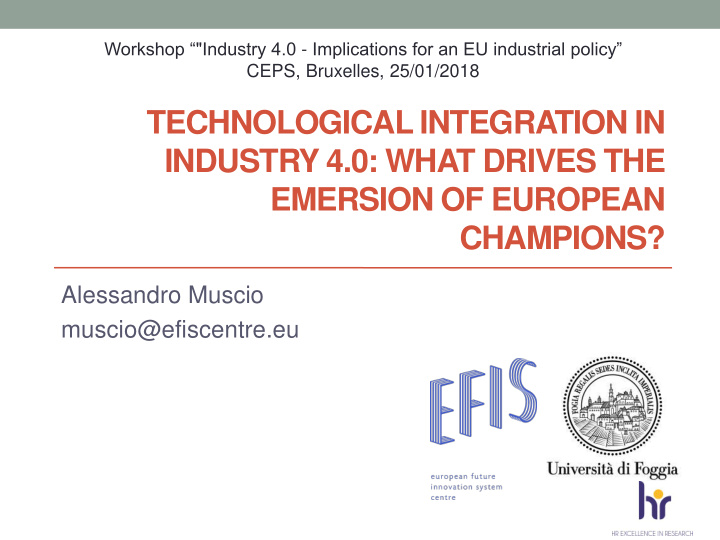



Workshop “"Industry 4.0 - Implications for an EU industrial policy” CEPS, Bruxelles, 25/01/2018 TECHNOLOGICAL INTEGRATION IN INDUSTRY 4.0: WHAT DRIVES THE EMERSION OF EUROPEAN CHAMPIONS? Alessandro Muscio muscio@efiscentre.eu
We are living an age of profound changes of the economic system as we know it • A broader renewal of interest in the role of manufacturing (EC, 2013) • The process of tertiarisation is still at the centre of the political agenda, but we have started to deal with the future of manufacturing • National strategies in Italy, Germany, France, the UK • Industry 4.0 is about changing the production process in the way it is systematically connected, informed and controlled
The gap • Economists have failed • We focus on the to realise the pervasive enabling technologies effects of Industry 4.0 developed with the support of the EC • Little information about • Data drawn from the the distribution of competencies across the RED database of EU approximately 10,000 research cooperation • No official classification of projects Industry 4.0 activities • FP7, "Cooperation ” and “ Capacities ” programmes • Source: Ismeri Europa, CORDIS data
The list of enabling technologies defined in the Italian plan for Industry 4.0 • Advanced Manufacturing Solutions • Interconnected, easily programmable collaborative robots • Additive Manufacturing • 3D printers connected to digital development software • Augmented Reality • Augmented reality supporting production processes • Simulation • Simulation between interconnected machines to optimise processes • Horizontal/Vertical Integration • Integration of information along the value chain, from suppliers to consumers • Industrial Internet • Multidirectional communication between production processes and products • Cloud • Management of big data on open systems • Cyber-security • Security in network operations and on open systems • Big Data and Analytics • Big data analysis to optimise products and processes
Total participations Germany Spain Italy United Kingdom France Greece Netherlands Austria Sweden Norway Ireland Finland Switzerland Belgium Denmark Portugal
The national “clubs” Germany - lead country in Industry 4.0, both in terms of 1. projects coordination and participation Wide participation of national firms in collaborative projects 1. Spain, Italy and the UK - upper half of a strong second tier of 2. countries with original capacities Project leadership in over 40% of cases 1. Balanced participation of RI and enterprises 2. France, Greece, the Netherlands and Austria - lower half of a 3. strong second tier of countries with original capacities Switzerland, lower rate of project coordination, but relatively high 1. rate of participation All other Member States - laggards, not possessing many 4. original capacities in any of the fields of Industry 4.0
Regional distribution of FP7 investments on Industry 4.0 Note: graduated intervals based on natural breaks (Jenks); classes: low (≤ EUR 7.1 million); medium - low (>7.1 and ≤18.9 million); medium (>18.9 and ≤38.1 million); medium - high (>38.1 and ≤60.9 million); high (>60.9 and ≤138.2 million).
HOW DO REGIONS SPECIALISE?
Regional centrality and specialization on Industry 4.0 enabling technologies Several ETs, high centrality
The regional “clubs” Peripheral specialised systems Isolated systems Second tiers in Industry 4.0 technologies. A relatively high number of regions (39 Their technological activities are more units, 13.3% of the total NUTS2) is not limited and less diverse, but still reach a involved in any Industry 4.0 project. certain critical mass. A range of opportunities for collaboration They can connect to European hubs but exist at the national level, but regional they strive to remain connected to central integration needs to be leveraged. research networks in Europe. Peripheral generalist systems Generalist hubs First tiers in terms of capacity to develop Many regions located in central Europe Industry 4.0 technologies. enjoy multiple and strong links to many Peripheral with respect to the first other regions in a relatively wide range of group and have not specialised in any enabling technologies. technology in particular. Polycentric systems, competitive companies and RIs. Hubs of wide inter- Their RIS may be less competitive than those of the 'generalist hubs'. regional systems of technological cooperation.
What drives regional participation? And Technological diversity? VARIABLES Frequency Diversity • Education GERD per capita (Ln) -0.005 0.015 • FP7 funding [0.025] [0.015] Employment manuf. (Ln) 0.242** 0.030 • Network centrality [0.043] [0.020] Tertiary education (Ln) 0.465** 0.113* • Outward [0.098] [0.049] FP7 contribution (Ln, IV) 0.201** 0.068** orientation +/- [0.031] [0.015] Network centrality 34.952** 2.195** [1.726] [0.800] Outward orientation 0.320** -0.049+ [0.066] [0.029] Outliers yes yes Constant -3.606** -0.229 [0.658] [0.291] Observations 222 222 R-squared 0.574 Pseudo R-squared 0.337 Robust standard errors in brackets ** p<0.01, * p<0.05, + p<0.1
Conclusions • Interregional cooperation in Industry 4.0 falls short of what might be desirable for the purpose of European integration and cohesion • This opens room for a stronger role of national policy in reducing intra-country regional disparities, fostering European integration and cohesion • Promoting education and regional networking should be at the core of our future agenda
Recommend
More recommend